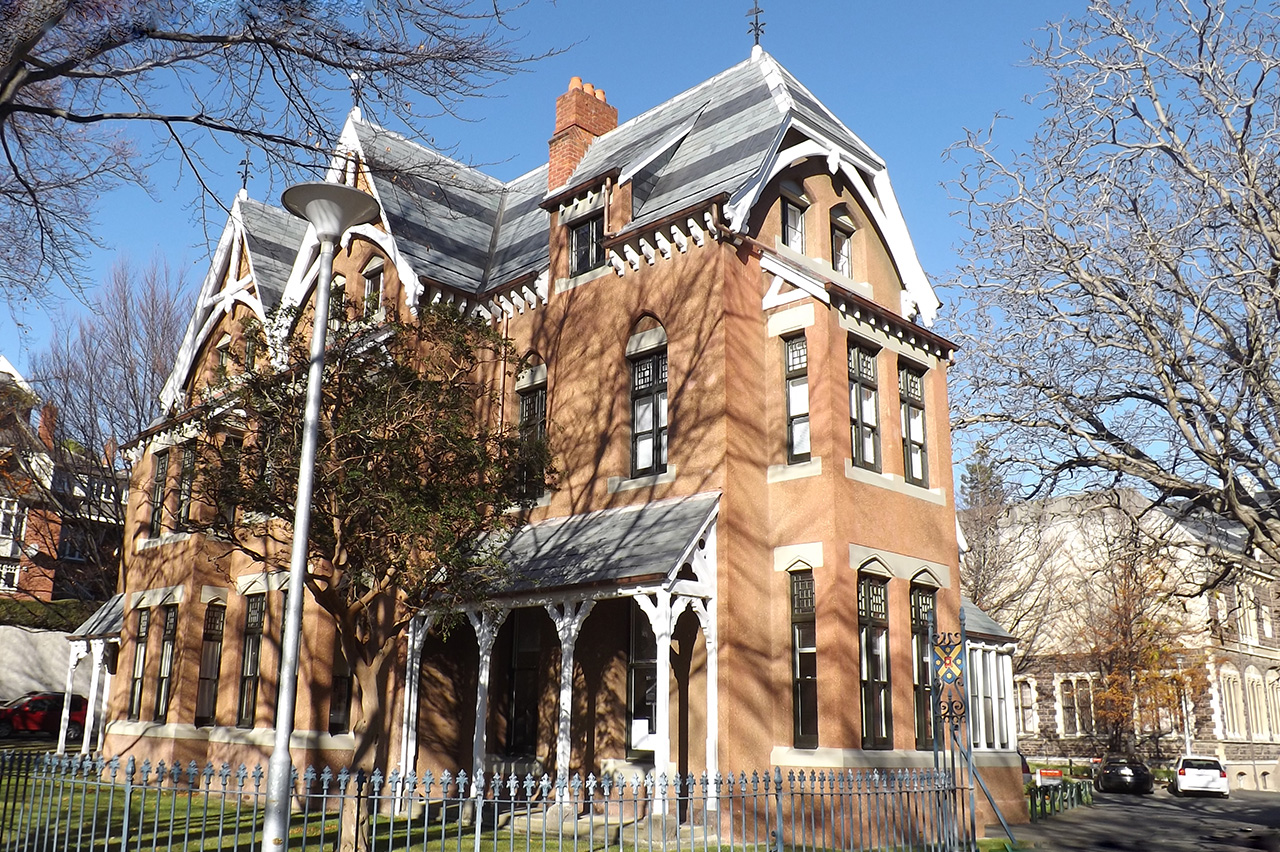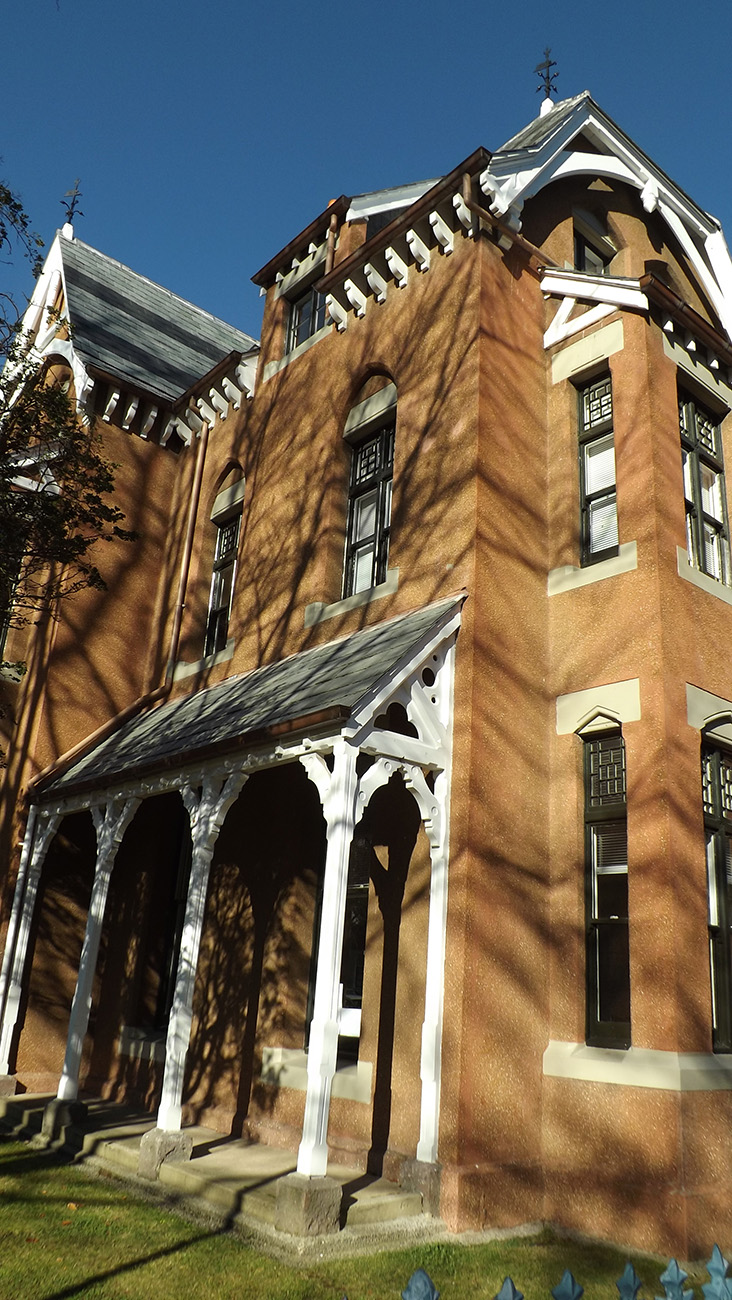Built to house the University of Otago’s first professors and their families, the Professorial Houses are a stately presence on St David Street at the northern end of campus. The Professorial Houses along with Clock Tower, Chemistry Building, the School of Mines are a distinguished complex of architecture dating from 1878, emphasising the value placed in Otago on higher learning. They have architectural and historical significance. Both iwi history and archaeological evidence show Māori occupation in the Ōtākou / Otago region since the 12th century. Today, Kāi Tahu mana whenua is recognised over a large part of Te Wai Pounamu. Kāti Māmoe and Waitaha shared occupation are always acknowledged. The hapū Kai Te Pahi, Kāti Moki, and Kāti Taoka still maintain their presence and responsibility as kaitiaki in this region. Traditional Māori place names include Ōwheo (the Water of Leith), a river that runs directly in front of the Clock Tower building and though campus, would have facilitated travel by waka from the coast to places further inland and the mouth of Ōwheo, known as Te Tutai o Te Matauira, was likely a valuable settlement area for accessing kaimoana and other resources. The Otago Provincial Council established New Zealand’s first university in 1869. By 1877 the University had outgrown that space and requested the government for use of the northern half of the land assigned for botanical gardens which was granted. In 1876 architect Maxwell Bury (1825-1912) won the competition for the design of the Clock Tower (List No. 62) and Geology (List No. 4765) and the Professorial Houses buildings for the Otago University. The complex of university buildings built between 1878 and the 1920s constitutes a major example of nineteenth and early twentieth century gothic in New Zealand. Built between 1878-1879, the Professorial Houses were designed as part of the original Bury Scheme. The decision to build the main University buildings in stone was influenced by the poor quality of Dunedin bricks at the time. However, a need to drastically cut costs led to the University Council building the Professional Houses in brick and reducing the number from six to four houses being built. The style of the houses has been described as domestic or romantic Gothic. The buildings are remarkable for their innovative use of this style which at the time of completion was gaining popularity through the work of Richard Norman Shaw in Britain. The use of the unconventional Queen Anne style, characterised by a variety of roof and window inclinations and dark red brick for the exteriors, originally disturbed members of the public. The Otago Witness noted “The Professors’ houses first startled observers by their extraordinary complications and inclinations of window and roof, and have eventually horrified all moderate tastes by blooming forth in a tint of the darkest and most inflammatory red”. Each house is relatively narrow for its height, being three stories high but they were designed to be generously proportioned. Together they form two well-proportioned individual blocks separated by domestic gardens and achieved a degree of separation from the University through plantings and limited access. The first professorial tenants were not originally those who were given their names to the houses. The residences were allocated according to seniority to Professor John Shand (1834-1914) (Mathematics and Natural Philosophy), Professor Duncan MacGregor (Mental and Moral Philosophy), Professor James Gow Black (1835-1914) (Chemistry) and Professor Hutton (Natural Science). When Hutton left in 1880, Scott took over the house and Sale later replaced Macgregor. In 1937 the first major internal change occurred when the Council turned one of the houses from a residence into professors’ rooms and small classrooms for the use of the Arts Faculty. In 1944 and 1945 the rest were converted in this way. By 1955 the Otago University Council Consultants architects stated, “Quite frankly, these buildings should be demolished as soon as the opportunity occurs”. The buildings, due to a need for at least one of them, did manage to survive so an extensive renovation was undertaken. All the houses were eventually painted and plastered with a reddish brown Moeraki gravel in 1957. The roofs were slate and were replaced in 1980 with asbestos cement shingles as well as the spouting and flashings replaces. The woodwork has over the years been badly attacked by borer. Today the houses are still called Sale, Black, Scott and Shand after some of the early professors. Today Student Services are situated in Scott Shand House, and University Flats is based in Black Sale House.


Location
List Entry Information
Overview
Detailed List Entry
Status
Listed
List Entry Status
Historic Place Category 1
Access
Private/No Public Access
List Number
4406
Date Entered
7th July 1988
Date of Effect
7th July 1988
City/District Council
Dunedin City
Region
Otago Region
Extent of List Entry
Extent includes the land described as Pt Blk LXXI Town of Dunedin, (RT OT299/36), Otago Land District and the buildings known as University of Otago, Professorial Houses, thereon.
Legal description
Pt Blk LXXI Town of Dunedin, (RT OT299/36), Otago Land District
Related listings
Stay up to date with Heritage this month
